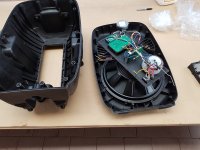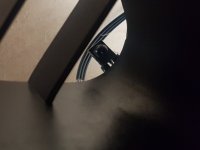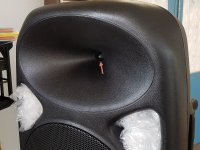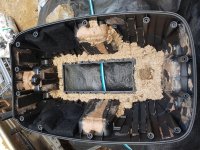I opened up a (very) cheap active speaker to see what's inside, and to apply mods.
There are two leads between the amp panel and the speaker's front panel:
1) connects to a power LED.
2) connects to something in the port.
What is this?
If I was going to guess, I'd say it was a mic, and it controls a high pass filter, to cheap the woofer from exploding at high SPL.
There are two leads between the amp panel and the speaker's front panel:
1) connects to a power LED.
2) connects to something in the port.
What is this?
If I was going to guess, I'd say it was a mic, and it controls a high pass filter, to cheap the woofer from exploding at high SPL.
Attachments
I don't think it is (another) LED.
The power LED on the front panel has 2 wires, this thing has 3. The location also seems odd for a LED, but reasonable for a sensor.
The power LED on the front panel has 2 wires, this thing has 3. The location also seems odd for a LED, but reasonable for a sensor.
Looks like an infrared receiver. Speaker controlled by remote?
Aha - that probably is it, thanks. It does have a remote. I never use it, so this didn't occur to me.
Looks like there's nothing stopping me from sealing up the ports, then.
What is it and how much ?.I opened up a (very) cheap active speaker to see what's inside....
Dan.
VEXUS SPS152
$200.
It is good enough for the role: I'm using it as a workshop system.
I got a pair of these (over other cheap options) because:
A) I like the horn, and might take a cast of it for other (better) projects
B) On a quick listen in store, it seemed pretty good for a cheap, flimsy speaker with piezo tweeters 🙂
C) much of what is wrong with them can be improved with cheap mods
The horn, cabinet design, features and the tweeter (actually a 'real' one, not a piezo) seem good for the price.
The negatives:
The cabinet is flimsy / boomy.
The horn throat and phase plug are a single, continuous assembly. It would require a hack & rebuild to use a different tweeter.
There is a misalignment and small gap where the two parts of the horn come together (pictured).
The amp has some quiescent noise. This is fine in a workshop (running a fan makes a lot more noise), but would not be good enough in a home / quiet environment.
My initial (low $) plan is to use lots of fibreglass + other fillers to strengthen and damp the enclosure. I'll try an ugly kludge to fill the seam in the horn.
I could potentially do a lot more, but I'll decide after I A/B the first tweaks. Other projects might be more worth my time.
$200.
It is good enough for the role: I'm using it as a workshop system.
I got a pair of these (over other cheap options) because:
A) I like the horn, and might take a cast of it for other (better) projects
B) On a quick listen in store, it seemed pretty good for a cheap, flimsy speaker with piezo tweeters 🙂
C) much of what is wrong with them can be improved with cheap mods
The horn, cabinet design, features and the tweeter (actually a 'real' one, not a piezo) seem good for the price.
The negatives:
The cabinet is flimsy / boomy.
The horn throat and phase plug are a single, continuous assembly. It would require a hack & rebuild to use a different tweeter.
There is a misalignment and small gap where the two parts of the horn come together (pictured).
The amp has some quiescent noise. This is fine in a workshop (running a fan makes a lot more noise), but would not be good enough in a home / quiet environment.
My initial (low $) plan is to use lots of fibreglass + other fillers to strengthen and damp the enclosure. I'll try an ugly kludge to fill the seam in the horn.
I could potentially do a lot more, but I'll decide after I A/B the first tweaks. Other projects might be more worth my time.
Attachments
Electret mic? Three wires: ground, live signal, power for capsule?
Just a though...perhaps to monitor output level for some protection?
Just a though...perhaps to monitor output level for some protection?
Quite remarkable cost/features ratio.VEXUS SPS152 $200.
It is good enough for the role: I'm using it as a workshop system.
A few mods and you can can have some fun with them.
IME these kinds of machines can nicely benefit by swapping out the Hu Flung Dung electros with something known and decent.
WES Components have Hitano caps that I have had good success with sonically.
Be prepared to increase values of coupling caps (OEM cost savings can cripple LF response) and supply caps.
Zobels on driver terminals too can reduce harshness.
Dan.
Indeed. I've begun fiddling with enclosure tweaks.Quite remarkable cost/features ratio.
A few mods and you can can have some fun with them.
IME these kinds of machines can nicely benefit by [...]
Be prepared to increase values of coupling caps (OEM cost savings can cripple LF response) and supply caps.
The electronics are LoFi mainly because of the quiescent noise. I don't know how to improve this.
If I want to / get time to really improve these, I think I'd simply swap the entire amp out (good amp boards are cheap, and I have a few in the post).
In this case, the Vexus amp would be demoted to subwoofer duties, and I might follow your advice regarding caps ...or I might just salvage the power supply and heatsink, and scrap the rest.
The good cost / features ratio makes sense when you see this $500 box: the Wharfedale WHARFEDALE TITAN 15D ACTIVE 15" SPEAKER looks very similar.
My guess is that the 'Injection Moulded Polypropylene' shell is made at the same factory. If they are already making jillions of Wharfadales, they can probably make additional shells for about $1 each, and use these to make lightweight knockoffs.
When I put my tweaked speaker back together, it sounded modestly improved, and cleaner when played loud. On testing (with several kg of damping, ports stuffed), the speaker was surprisingly flat 100Hz - 10kHz, but rolled off rapidly either side of that.
The LF cutoff is probably set by the small box (the Wharfedale features a 'Switchable 90Hz Monitor Filter' so they probably also die at ~100Hz) and the HF is probably set by the cheap tweeter / simple phase plug (the Wharfedale looks like it has a better tweeter).
I got about ~2kHz more extension when I filled in the seam in my tweeter's throat. I don't think I'll get a lot of benefit tweaking it much further.
Next step is to cast & clone the horns, and make a system with higher quality parts & aspirations.
My guess is that the 'Injection Moulded Polypropylene' shell is made at the same factory. If they are already making jillions of Wharfadales, they can probably make additional shells for about $1 each, and use these to make lightweight knockoffs.
When I put my tweaked speaker back together, it sounded modestly improved, and cleaner when played loud. On testing (with several kg of damping, ports stuffed), the speaker was surprisingly flat 100Hz - 10kHz, but rolled off rapidly either side of that.
The LF cutoff is probably set by the small box (the Wharfedale features a 'Switchable 90Hz Monitor Filter' so they probably also die at ~100Hz) and the HF is probably set by the cheap tweeter / simple phase plug (the Wharfedale looks like it has a better tweeter).
I got about ~2kHz more extension when I filled in the seam in my tweeter's throat. I don't think I'll get a lot of benefit tweaking it much further.
Next step is to cast & clone the horns, and make a system with higher quality parts & aspirations.
Sort of. I've fiddled with full range drivers and tried the usual cone tweaks.
Some can make a minor difference (I've measured cleaner impulse plots), but it seems impossible to fix big problems like obnoxious spikes / roller coaster frequency response.
In this case, the 15" is already OK (better than it looks). All I did was put some felt on the basket figuring it might do some good, and would do no harm.
The thin cabinet seemed to be the weakest link (fixed, with about $10 of materials), now I think it is the amp and tweeter, which would cost more than is worthwhile on a speaker this ugly 🙂
Photo is of the cabinet rear, damping goo applied (fibreglass, glue, filler, rubber from recycled tyres).
By the way, this still reeked for at least a week after I put the cabinet back together, and it still works fine. The fumes didn't melt anything.
Some can make a minor difference (I've measured cleaner impulse plots), but it seems impossible to fix big problems like obnoxious spikes / roller coaster frequency response.
In this case, the 15" is already OK (better than it looks). All I did was put some felt on the basket figuring it might do some good, and would do no harm.
The thin cabinet seemed to be the weakest link (fixed, with about $10 of materials), now I think it is the amp and tweeter, which would cost more than is worthwhile on a speaker this ugly 🙂
Photo is of the cabinet rear, damping goo applied (fibreglass, glue, filler, rubber from recycled tyres).
By the way, this still reeked for at least a week after I put the cabinet back together, and it still works fine. The fumes didn't melt anything.
Attachments
- Status
- Not open for further replies.
- Home
- Loudspeakers
- Multi-Way
- Unknown sensor in port



